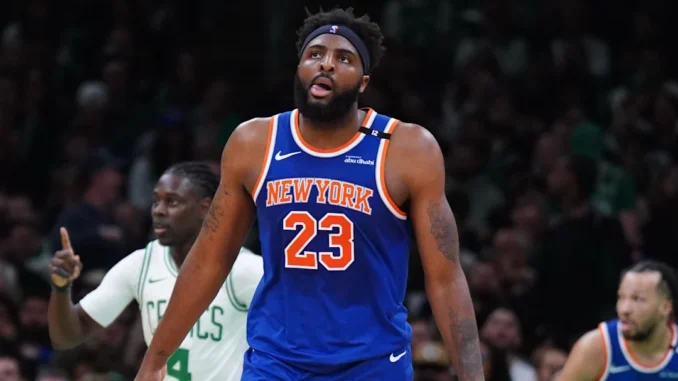
Knicks Big Man Not Worried About Starting Lineup Dilemma:
The New York Knicks are preparing for the 2025–26 NBA season with one of the deepest frontcourts in the Eastern Conference. With stars like Julius Randle, Mitchell Robinson, and newly extended Isaiah Hartenstein, the team finds itself in the enviable yet challenging position of having multiple players capable of starting in the paint. For many organizations, this might create a headache, or even stir discontent among players eager for larger roles. Yet, according to the Knicks’ big men themselves, there’s little concern about who hears their name called with the starting lineup.
One particular Knicks big man addressed the so-called “starting lineup dilemma” this week, downplaying its importance and emphasizing that the team’s focus should remain on winning games, not individual titles. His attitude reflects a culture of selflessness that has been growing under head coach Tom Thibodeau — and it may be one of the Knicks’ most valuable assets heading into the season.
A Crowded Frontcourt:
The Knicks’ roster is loaded with size and versatility. Julius Randle has been a centerpiece of the franchise for several years, an All-NBA forward capable of scoring in bunches and rebounding at a high clip. Mitchell Robinson remains one of the league’s premier rim protectors and offensive rebounders when healthy, while Isaiah Hartenstein emerged last season as a two-way contributor who impressed with his passing, defensive IQ, and hustle plays.
Adding to the mix are developing young forwards like Jericho Sims and versatile wings who can slide up to play small-ball lineups. The result? Thibodeau has an array of options depending on matchups, but also a situation where at least one proven big man will have to come off the bench.
The Player’s Perspective:
Instead of fueling tension, the Knicks’ big man at the center of speculation brushed aside concerns. “For me, it doesn’t matter if I start or come off the bench,” he told reporters. “The important thing is being on the floor when it counts — the last five minutes. I just want to help the team win.”
That perspective is refreshing in an era when players often measure their status by starting roles or statistical accolades. By focusing on contribution over designation, the big man is reinforcing the Knicks’ broader message: defense, effort, and teamwork first.
Why the Dilemma Exists:
The Knicks’ style under Thibodeau places heavy emphasis on defense and rebounding. Robinson’s shot-blocking and vertical spacing give the team a unique advantage, while Randle’s offensive versatility allows him to create mismatches. Hartenstein, however, offers the type of passing from the high post and pick-and-roll facilitation that complements the team’s guards.
Choosing which two of the three bigs to start alongside the backcourt isn’t a straightforward task. Matchups often dictate lineups — against small, perimeter-heavy teams, the Knicks might prefer Randle and Hartenstein, while against bigger, more physical opponents, Robinson’s defensive presence is invaluable.
The Value of Depth:
In truth, what might be labeled as a “dilemma” is closer to a luxury. Few NBA teams can boast three starting-caliber big men, and the Knicks have that at their disposal. Injuries, foul trouble, and the grueling nature of an 82-game season mean that depth is a necessity, not an inconvenience.
The Knicks’ bench unit was a strength last year, and keeping one of their top bigs in a reserve role could continue that trend. Hartenstein, for example, thrived in extended minutes when Robinson was sidelined with injury. Similarly, Sims has shown that he can provide energy and rim protection in short bursts.
Emphasis on Team Chemistry:
What stands out most is the culture that has developed in New York. A few seasons ago, questions about the Knicks’ identity and locker room cohesion swirled. Today, the narrative is different. Players have bought into Thibodeau’s system and understand that sacrifice is necessary if the team wants to move beyond first-round playoff exits.
The big man’s nonchalant attitude toward starting roles is emblematic of that culture. Rather than lobbying for minutes or creating drama, he has embraced the philosophy that winning cures all. If the Knicks succeed, individual recognition will follow naturally.
Playoff Implications:
Ultimately, what matters most is the postseason. The Knicks are expected to be a serious contender in the East this year, and playoff matchups will determine rotations more than anything else. Some series might call for Robinson’s rim protection, others for Hartenstein’s passing, and others for small-ball versatility.
Having multiple options gives Thibodeau flexibility and allows the Knicks to adjust mid-series — a luxury they didn’t always enjoy in past years. The big man’s willingness to accept a fluid role ensures that the team can prioritize strategy over ego.
Conclusion:
The Knicks’ so-called starting lineup dilemma at the big man position may generate headlines, but within the locker room, it appears to be a non-issue. For the players involved, particularly the one who downplayed its significance, the goal is clear: focus on team success, regardless of who starts.
In a league often defined by individual stardom, the Knicks’ approach emphasizes collective responsibility. That mindset could be the difference between another solid season and a deep playoff run. Far from worrying about who begins the game, the Knicks are more concerned with who finishes it — and with their talent and depth, they might just finish the season as one of the East’s true powerhouses.

Leave a Reply